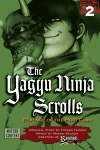
When the men of the Hori clan rebel against the villainous Lord Akinairi, he orders them to be mercilessly slaughtered by a group of blood-thirsty ninjas known as “The Aizu Seven Spears”. Enraged by the callous murder of their brothers, fathers, and husbands, the 7 surviving women of the clan turn to a vagabond swordsman named Yagyu Jubei for training in the ways of war and leadership in their quest for revenge. Jubei is no starry-eyed optimist, and warns the women that most of them can expect either torture or death at the hands of Akinari and the Seven Spears if they choose to fight back. Undaunted, all 7 women agree to train and fight the Seven Spears – or die trying!
This manga’s basic plot – a cocky, wandering swordsman fighting off 7 weird opponents – is essentially the same plot as the classic Ninja Scroll movie and the Samurai Showdown video game. Interestingly, all three of these works are drawn from the writings of Futaro Yamada, who effectively laid the groundwork for the modern depiction of the ninja in his 1960’s series of Ninpocho novels. Main protagonist Yagyu Jubei is a popular Japanese folk hero, and like fellow wandering swordsman Miyamoto Musashi, his legendary exploits have been depicted in dozens of books, manga, and films
There are slightly fantastic elements to this series, but very little of the outlandish video-game like costumes or characters you often see in “ninja” series (or even in Masaki’s previous ninja-centric Basilisk); this is a much more “realistic”* depiction of the art of ninjitsu than the average Naruto reader may be used to. The watercolor-influenced shading and tinting gives a luminous feeling to what is basically a very dark and foreboding art style. Masaki succeeds in making the Seven Spears look truly villainous, and Jubei and the Hori woman aren’t spared either. As handsome as he is, Jubei spends most of the volume looking like smirking lecher, a quality that his constant 5 o’clock shadow and missing eye do nothing to help. The Hori women are both eerily beautiful yet terrifying when angry; when their doe eyes narrow in fury, they truly resemble the female demon masks that they wear to hide their identities.
With the exception of the characters of Sakura and Ofue, most of the seven Hori women are somewhat similar in their appearance and personality - but I hope that the following volumes will draw out the character of each one of them. I also enjoyed the depiction of the Hori woman as brave and willing participants in their fate, rather than anonymous objects; even in the course of this one volume, one can see them gain in strength and ability.
In this volume, a devil-masked Jubei confronts the sickle-and-chain wielding Tessi of the Seven Spears, and barely escapes with his life. Tessi reports back to the Seven Spears, and they debate the origin of their new and unknown opponent; meanwhile, the Hori women begin their training with Jubei. Rough and painful as the training is, the women remain committed. When it comes to light that fiendish Tessi is attempting to sell 6 young women into sex slavery, the Hori women must use their new-found skills – and Jubei’s tactics of subterfuge – to kill Tessi. Are they ready?
This series has a well-deserved Mature Rating – so much like Welcome to the NHK, don’t come crying to me if your mom gets pissed when she finds this in your bookbag, kids.
* Even then, this is a far cry from the real-life exploits of the historical ninja
No comments:
Post a Comment